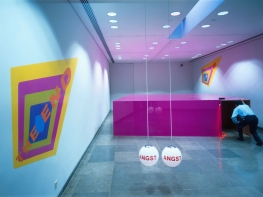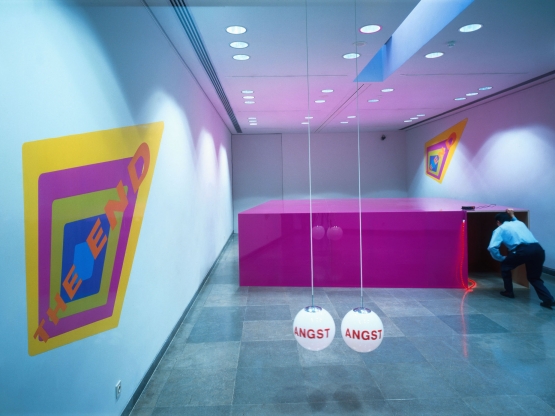An End & Other Ends
Pedro Lapa
Pedro Lapa
The work of Henrik Plenge Jakobsen has Situationism as its historical Danish antecedent, which functioned as a theoretical horizon for many of the artists of the Cobra movement, such as Asger Jorn, and the experiments and concepts of the art / life relationship developed by the Fluxus movement. In a certain manner his work is also a reaction to the interval between these attitudes and the emergence of a new generation, which is his, committed to establishing new relationships between the work and the viewer. However, it is important to stress that the antecedents of his work are not restricted to a history or tradition that are strictly national, because the above-mentioned groups, made up of artists from diverse origins, formed openly stated rejections of this nationalist principle of the understanding of a history or tradition. The constitution of a horizon of issues essentially centered on the work as an interactive device with a great communicative efficiency is thus the center of his works, whether they are performances or installations.
In The End, there is a coming together of several works and issues that the artist has been developing over the last years, such as the inscription of verbal signs associated to socially-felt symptoms, and which are visually presented in order to expand their meaning; or also a set of works, perhaps the most well-known, that through a device central to the installation, provoke a certain interactive behavior with the overall meaning of the work. This installation by Henrik Plenge Jakobsen is developed over the idea of an end and its cliché at the moment, a theme that at this end of millenium has exhaustively fuelled discourses ranging from aesthetics and the history of art to the mass media or to advertising. Independently of the reasons which animate them, all of these discourses use the term in such diverse manners that it has become what Roland Barthes designated as a floating significant, which signifies nothing on its own but seems to raise and justify the very existence of this hysterical proliferation of discourses. The several elements that make up the installation are inscribed within this idea, significantly crossing through several orders of reference and subjecting them to the experience of the visitor.We then find a large box covered in acrylic which takes up over a third of the room, and which evokes the memory of Donald Judd's specific objects; yet their shocking pink color differentiates them and grants them with a very different Pop aspect. On the walls of the room two large vinyl stickers, which seem like logos, and on which is written the words The End, make a vague reference to Systemic Painting, namely that of Kenneth Noland or of Frank Stella. But here the aspect of the icon for mass-consumption is also superimposed over these references. In this manner, we may register a first crossing between the memory of Modernist works, traditionally associated to its end, and the popular culture shown in the colors, materials and presentation, which in a purely Modernist perspective would be seen as kitsch.
Two lampshades, with Danish design from the fifties, giving out an intense pink light, have the word Angst written on them, responding to The End in the logo and predicting the visitor's experience.The box has an opening on one of Its corners, from which there hangs a hose of intermittent red light, requesting the gaze to follow it until it is lost In the darkness, and curiosity incites the visitor to enter.
Within the gloomy path, only lit up by the hose, is shown to be a vaster maze than one might imagine, capable of provoking claustrophobia and anxiety in those who go through it. The strictly visual perception to which Modernism confined the work of art, and to which box this refers, is superimposed by the corporal experience that turns out to be very different, something painful and unpleasant. Contributing towards this
is the time of the experiment, which, in going beyond the limit of the expectations, returns the attention of the body to the body itself and is obliged to continue the path, beyond the satisfying of curiosity, its initial aim.
A clear contrast is thus established between the seduction of the visual aspect and the physical experience of the maze, yet the crossing of their meanings is much more complex than it may seem at first sight. This returns to us the cliche of the ends as an anecdote, beyond which exist our existence and awareness of the world.
If the series of specific objects by Donald Judd may mark out the extreme limit - the end - of a Modernist paradigm, they are also its overcoming through the implication of the temporal nature in the forming of their perception. The differences and repetitions that the series of “boxes”, present, define perception as a process of unification of their data. So the fact that we can enter these objects, and experience it through a more interactive process, does not only amplify the aspects that make up an overcoming of Modernism, but also returns to us the awareness of an inevitable path beyond the ends and its arbitrary nature. In this sense the ends are a mobile territory which is needed to be questioned through the contexts of meaning that they produce and which produce them. If a work by Judd may be seen as an end, or, paradoxically, the disclosing of another horizon, it is towards another horizon that this work by Henrik Plenge Jakobsen sends us; that is, the work as a trap or interactive device for the deconstruction of some of the cliches of contemporary culture.
In mixing references from an avant-garde culture with some aspects of popular culture throughout which run the same order of questions, it is not a stating that kitsch and the industries of culture are formed as reifications of the enunciations of the former, but that the avant-garde is also placed within the same order of questions that it is necessary to comprehend as an ideological mechanism and to proceed to its deconstruction. Thus, to speak of the end of Modernism may be so laughable for the artist as the end of history or other ends, principally if we see Modernism as a critical work served by a dynamic process, capable of dealing with the growing complexity of the references which give it life. In an installation in which the history of the objects hurls them in several superimposed directions, and their distribution forces us to think upon the complexity of relationships they hold, Super-Modernity may well be the most adequate designation, as remaining the hostage of the collapsing of an aim is open to the most diverse misunderstandings.











